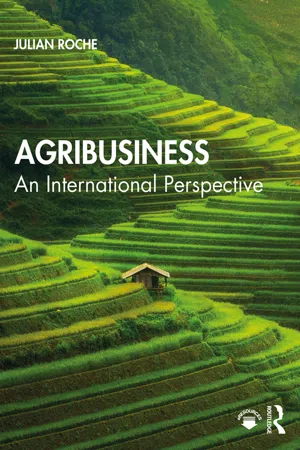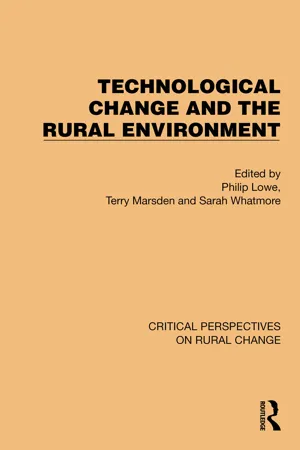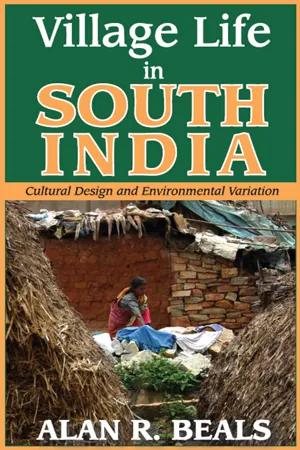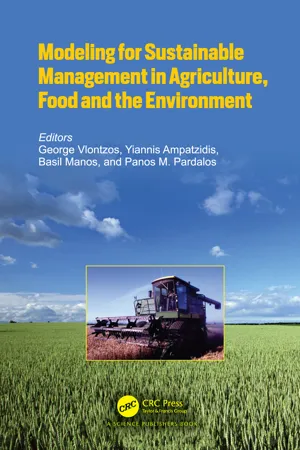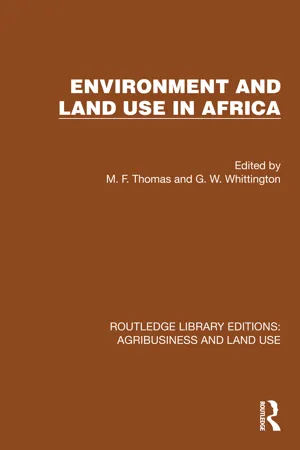Geography
Technology and Agriculture
Technology and agriculture refer to the application of modern tools and techniques in farming practices. This includes the use of machinery, irrigation systems, genetic engineering, and precision farming methods to improve crop yields, reduce labor, and enhance sustainability. The integration of technology in agriculture has led to increased productivity and efficiency in food production, impacting both rural and urban landscapes.
Written by Perlego with AI-assistance
Related key terms
6 Key excerpts on "Technology and Agriculture"
- eBook - ePub
Agribusiness
An International Perspective
- Julian Roche(Author)
- 2019(Publication Date)
- Routledge(Publisher)
CHAPTER4
The role of technology
Introduction: a difference in approach
I imagine that most readers of this book are interested in the business of agriculture, in one or more capacities of regulator, lender, investor, supplier or adviser. It is always necessary to decide, even for scientists and certainly for business people, what research is needed, and for what purpose, and then to select only the latest and/or most relevant research. Agricultural scientists are often, it must be recognised, not especially well versed or even interested in economics or finance. Even basic concepts such as cost-benefit analysis are often alien, whilst on the other hand scientific jargon is rife. The best way to approach the dichotomy between their vast experience, dedication, research and achievements, and their oft-evidenced disinterest in finance, is to regard agricultural research as a data resource for financial decision-making. Certainly, the application of agricultural science has major financial impacts. This chapter has been written as an introduction to agtech and agricultural science with that aim in mind.Principles of agricultural science and technology
What is agricultural science? Agricultural research – the Australian government tells us – is not an actual scientific discipline in its own right. Rather, it is a broad term to describe the application to agriculture of many different scientific disciplines and endeavours, combined with the objective of achieving improvements in agricultural output, sustainability and, sometimes, profitability. Primarily, but perhaps regrettably, agricultural science integrates scientific disciplines in which research may have been carried out without an explicit end-point application. Traditionally this has involved all of botany, zoology and soil science including, inter alia - eBook - ePub
- Philip Lowe, Terry Marsden, Sarah Whatmore(Authors)
- 2023(Publication Date)
- Routledge(Publisher)
critical importance to poor people in low resource areas: for example, post-harvest technology and storage, agro-forestry, decentralised marketing, improved transport, better biomass utilisation and alternative sources of income generation. Plugging the ‘agricultural technology’ gap means sharing skills and knowledge in the implementation and adaptation of technology as well as developing appropriate technology.- Poor people’s calculations, like our own, are based on what they know and what they can anticipate. Better environmental monitoring and forecasting are therefore necessary, and the resulting information and predictions should be much more widely disseminated.
‘Enhancement’ areas
‘Enhancement’ areas can be defined as those where there is a potential for intensive crop production, using existing technologies, but with more attention to the environmental costs of agricultural practices. Such areas are frequently irrigated or include reliable rainwater on rain-fed land. Soils are generally good. Agricultural technology has been developed in these areas to exploit the relatively favourable resource base and to raise the ‘carrying capacity’ of the land. The priority now is to ensure that the land’s productive capacity is not seriously compromised, while reducing vulnerability to environmental hazards, many of which occur as a result of the technical transformation of agricultural production. Figure 4.1 indicates that ‘enhancement’ areas need to be considered within the context of other, geographically contiguous zones, such as watershed forests, which themselves need to be developed more sustainably.The development ‘success’ story of the late 1960s and the 1970s was the so-called ‘Green Revolution’ which was devised for ‘enhancement’ areas and which served to transform the internal balance between irrigated and non-irrigated areas of developing countries. The Director General of the International Rice Research Institute has captured the rapidity of ‘Green Revolution’ advances in the following remark:India received nearly 10 million tonnes of food grains during 1966, largely from the PL480 Programme of the USA. It was in the same year that the Government of India initiated a High Yielding Varieties Programme in order to make food aid unnecessary as quickly as possible. Consequently, by 1971, a grain reserve of over 10 million tonnes was built up. (Swaminathan, 1986 - eBook - ePub
Village Life in South India
Cultural Design and Environmental Variation
- Alan R. Beals(Author)
- 2017(Publication Date)
- Routledge(Publisher)
Chapter 3 AGRICULTURAL TECHNOLOGYThe karma of the rural community is raising food crops. The farmer often sees himself as a practical man unaware of theological and intellectual subtleties, yet he never doubts his importance in the scheme of things: “One man must plow so that twenty may eat.” Although not all members of the community belong to jatis whose primary social responsibility is agriculture, almost every resident in a rural village is a farmer of farm laborer as well as a practitioner of a traditional occupation.Rainfall, soil, seasons, temperatures, and other aspects of the environment that affect the raising of agricultural crops are crucial to the fulfillment of the village’s sacred purposes. The farmer, the man who manages (even if he does not directly own) particular plots of land, must select plants and agricultural techniques that will permit him to reap a profitable harvest. If the soil is poor and the harvests are small, the village may be isolated from other villages and communities because it lacks the capital required to entertain visistors, attract and manipulate government officials, and draw tradesmen and entertainers.To survive, a village must produce enough crops to support its population, build up a stockpile against bad years, and satisfy such needs as the purchase of clothing and the payment of taxes. The maintenance of village populations, elaborate systems of social stratification, and complicated ceremonial patterns depends on the quantity of agricultural production. In choosing particular techniques to exploit available resources, the members of the village commit themselves to particular activities: cattle must be fed and watered daily, and crops must be harvested within a few days after they ripen.The application of agricultural technologies to village lands involves subtle and complex interactions not only within the village but also between the village and neighboring communities, government agencies, and supernatural beings. To simplify matters, this chapter emphasizes the technology that is applied directly in grain farming, animal husbandry, and fruit and vegetable production. Although these three basic technologies are closely related, the most significant involves the production of the grains ragi (Eleusine coracana), jolla (Sorghum vulgare - George Vlontzos, Yiannis Ampatzidis, Basil Manos, Panos Pardalos, George Vlontzos, Yiannis Ampatzidis, Basil Manos, Panos M. Pardalos(Authors)
- 2021(Publication Date)
- CRC Press(Publisher)
Silva et al. 2011 ).The following case studies and applications of modern technological means help to achieve the basic objectives of the circular economy at all stages of the agri-food chain.Technology Applications in the Field
The proper and ‘smart’ design of agricultural products, based on applying the most efficient way of exploiting the available resources in the production method, is the first and foremost stage of agricultural production where the circular economy can be applied. It aims to reduce as much as possible the production of waste from agricultural activity while increasing the profit for the producer (Toop et al. 2017 ). As mentioned earlier, producers nowadays, and in the near future, are facing the challenge of cultivating more, with the use of as limited inputs and water as possible, while at the same time having to cope with adverse weather conditions caused by climate change. Additionally, they have to adapt to the ever-increasing demand for food and meet diverse and ever-changing consumer preferences. A feasible means to achieve these goals is through the adoption of new technological methods and innovations in agricultural production.Biotechnology–Genetic Improvement
Applications of plant biotechnology and genetic engineering in agriculture have led to the creation of new varieties of plants with improved characteristics, while at the same time contributing significantly to environmental protection. In order to achieve economic and environmental sustainability in a farm production system, innovative processes need to be developed and significant obstacles overcome. The technological advances of recent years have led to the development of a new generation of plant improvement techniques (Wieczorek and Wright 2012 ). Recent techno-economic analyzes have shown that biotechnological processes give the opportunity of recycling and upgrading CO2 emissions into high-value end-products, while utilizing each component of the original biomass in an integrated management framework, are leading to the development of a sustainable and circular bio-economy (OECD 2019). Thus, through advances in biotechnology, it is possible to automate large-scale plant phenotypes, in the field or in a greenhouse, using digital systems. This technology is called phenomics and helps to understand the interaction between a plant and its environment. It is a very useful tool for crop management and can be applied with the use of optical sensors. Biochemical and anatomical properties of the crop are sketched without requiring a conventional visit of an expert to the field (Mahlein 2016- eBook - ePub
- Anthony Bebbington, John Farrington, David J. Lewis, Kate Wellard(Authors)
- 2005(Publication Date)
- Routledge(Publisher)
Our discussion in the final part of the chapter falls into two broad areas: first, we emphasize that NGOs’ philosophies and the approaches to ATD through which they are articulated are neither uniform nor static: they have evolved with field experience, with changes in the political, economic or institutional context, with increasing awareness of the wider changes in thinking on development and the environment, and through pressure from donors. Second, we raise questions about NGOs’ costs and performance in relation to those of government in the various parts of the ATS in which they have chosen to work.SOME DEFINITIONS
The definitions of both agriculture and of technology in this book are broad.1 We define technology to embrace:- Hardware (e.g. seeds, vaccines, machinery);
- Management practices and techniques (e.g. soil and water conservation practices, rotations, crop mixes, agroforestry);
- Increments in knowledge (whether traditional, modern or some combination of the two) that strengthen local capacity for experimentation, communication and general resource management.
While all three of these elements are of concern to both NGOs and governments, NGOs’ concern with participation and empowerment suggests that the third— especially the development and sustainability of local knowledge systems—would be of particular interest to them. While improvements in each of the three increase production efficiency, the impacts of such improvements are unlikely to be neutral among different groups in the population. Thus, our interest in this chapter lies in both the production and the distributional impacts of the technical change promoted in the work of differing NGOs. The issue then arises as to how far NGOs’ organizational characteristics also influence the nature of these production and distributional impacts. We touch on this theme in this chapter, but develop it in greater detail in Chapters 4 and 5 - eBook - ePub
- M. F. Thomas, G. W. Whittington(Authors)
- 2023(Publication Date)
- Routledge(Publisher)
Despite these problems, a strong case that geographers should pay more attention to tropical agriculture can be made, on both practical and academic grounds. In the foreseeable future it is likely that agriculture will continue to occupy a leading place in the economies of African countries and, both out of academic self-interest and as responsible citizens, geographers ought to play a part in economic development by employing their skills in describing and understanding the existing use of agricultural resources and so contributing to the planning of their more effective exploitation; for the geographer’s concern with total environment, both physical and human, and his training in methods of reconnaissance survey are very appropriate in countries in tropical Africa, whose problems are often too urgent to wait on detailed inquiries by many specialists. It would, of course, be wrong to allow such immediate practical objectives wholly to dictate academic priorities, but geographers may find it easier to obtain data for strictly academic investigations when they have demonstrated their capacity to make practical contributions. In any case, the distinction between academic and practical should not be over-stressed; a better theoretical understanding of the location of agricultural production may be expected to increase geographers’ ability to predict the likely results of proposed changes and so make a more effective contribution to the planning process and, conversely, the investigation of the agricultural consequences of, say, the construction of new communications may lead to improvements in theory. In this respect, the tropics offer opportunities which are not so readily available in the developed world; the existence of large numbers of peasant farmers, operating on a small scale in an environment with few external links and a relatively simple economic climate and yet subject to radical and rapid change, offers the nearest approach to laboratory conditions that the social scientist is likely to find.The central aim of agricultural geography as an academic discipline is an understanding of the complex variety of agricultural patterns on the earth’s surface. These may be examined at all scales, from the world and continental views characteristic of general atlases and textbooks to the ultimate unit of decision-making, the individual farm. In practice, the minimum area is more likely to be a group of farms or the territory of a village or other similar rural community, since the geographer, like the economist and the sociologist, is generally more concerned with the trends and tendencies which are the resultant of many individual actions, although he recognizes that individual decisions and idiosyncrasies may be important where the unit of decision-making is large. For the agricultural geographer working in tropical Africa no one scale is intrinsically more appropriate than another and both large- and small-scale investigations present difficulties. The choice of the scale will depend upon the nature of the problem being investigated and upon the resources available for its solution. Where farms are very small, as in most of tropical Africa, the territory occupied by a single rural community is likely to be the largest area which can be studied comprehensively in the field by an individual investigator, especially if he has to rely on field observation and inquiry for all his data. Much larger areas can, of course, be studied more superficially on a reconnaissance basis, by sampling, by reliance on secondary sources, by teamwork, or by Umiting the aspects to be investigated, and all these approaches have a part to play.
Index pages curate the most relevant extracts from our library of academic textbooks. They’ve been created using an in-house natural language model (NLM), each adding context and meaning to key research topics.
